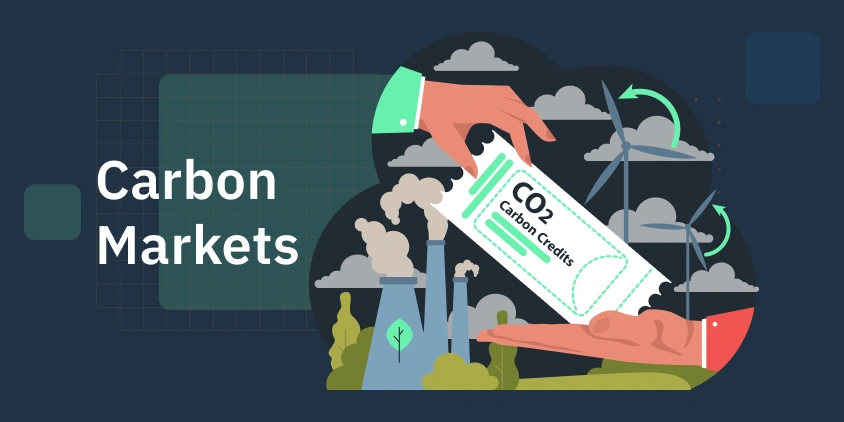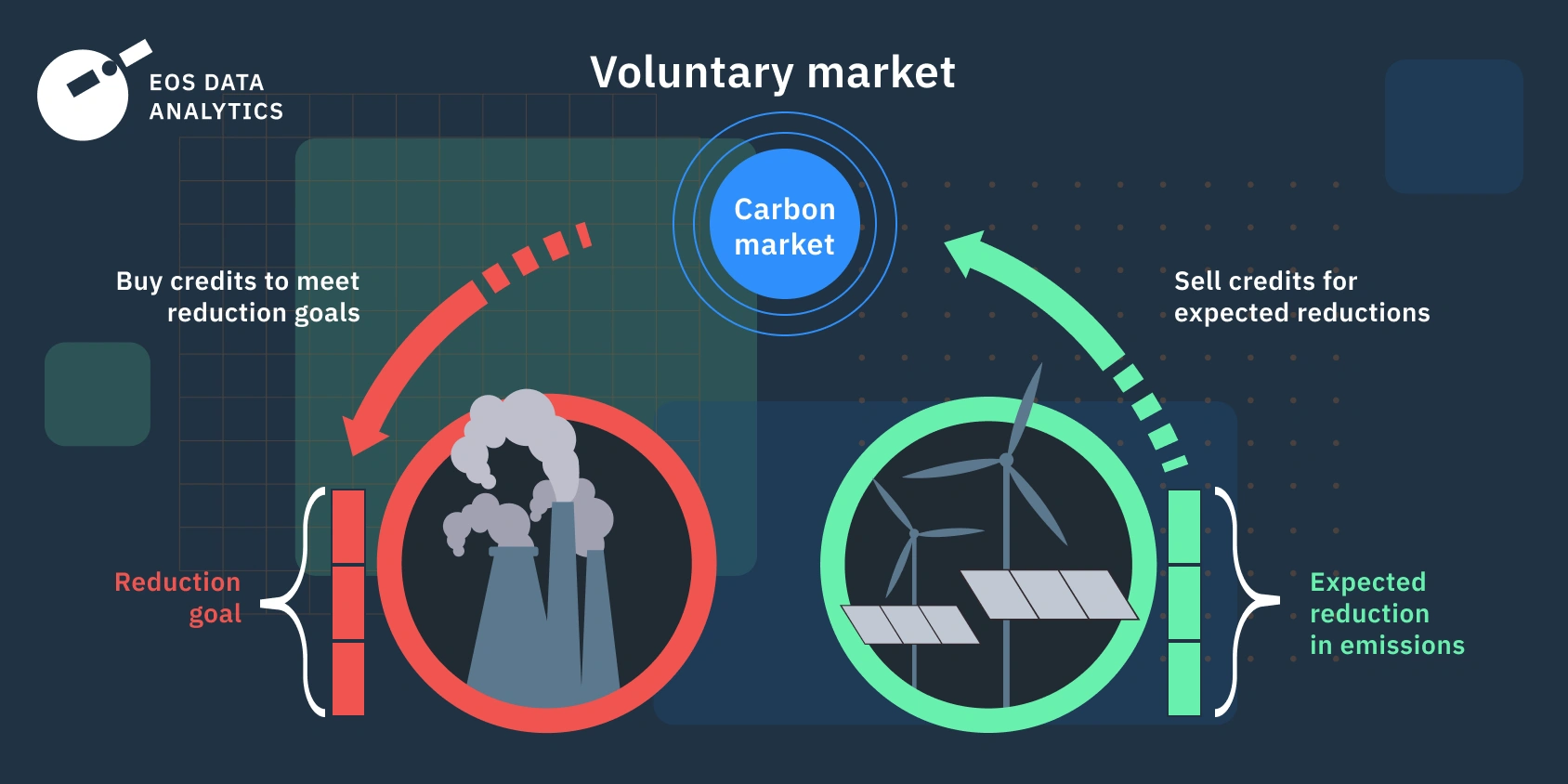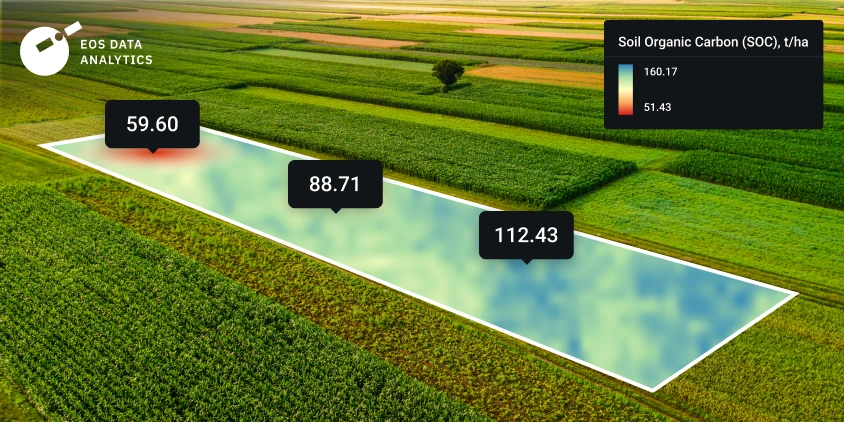
Carbon Markets: Principles, Impacts, And Future Outlook
Remember when tackling climate change seemed like a job only for governments and big corporations? Carbon markets are flipping that script. These innovative systems are changing the game, turning emissions reduction into a smart business move for businesses across multiple industries. Whether through mandatory programs or voluntary efforts, more and more businesses and individuals are getting in on the action. As carbon marketplaces mature, cutting-edge technologies are breaking down barriers to entry, democratizing access and ensuring that emission trading becomes an integral part of the world’s transition to a low-carbon future.
What Is The Carbon Credit Market?
The carbon credit market is a specialized financial system designed to address climate change through financial incentives. It revolves around the trading of carbon credits (CCs), which are permits allowing the release of a specified amount of greenhouse gases (GHGs).
Carbon trading markets operate on a simple principle: companies that reduce their emissions below mandated levels can sell their excess credits to those struggling to meet their targets. This creates financial motivation for businesses to lower their environmental footprint. By putting a price on GHG emissions, these marketplaces help integrate environmental costs into business decisions, facilitating a smoother transition to a low-carbon economy.
Types Of Carbon Markets: Compliance Vs. Voluntary
Marketplaces for credit trading play a crucial role in global efforts to reduce greenhouse gas levels. There are two primary types of carbon markets, each with distinct characteristics:
- Compliance. These are cap-and-trade-based systems, typically implemented by governments. They set a limit on greenhouse gas releases and allow the trading of permits among regulated entities.
- Voluntary. These are carbon offset markets, where companies and individuals can voluntarily purchase credits from projects that reduce or remove CO2 from the atmosphere.
Both systems aim to put a price on greenhouse gases, encouraging businesses to lower their emissions and invest in greener technologies. This table outlines the key differences between two types of CC marketplaces.
| Compliance | Voluntary |
|---|---|
| Mandated and regulated by governments | Driven by corporate social responsibility and individual choice |
| Based on a cap-and-trade system | Based on offsetting mechanisms |
| Operate at national or regional levels | Function globally without geographic restrictions |
| Have active futures permit trading | Permits are primarily traded through forward contracts |
| Available for investment via Exchange Traded Funds (ETFs) | Limited structured investment products available |
| Penalties for non-compliance | No legal penalties, but reputational risks exist |
Now that we’ve outlined the key differences between compliance and voluntary carbon markets, let’s take a closer look at each type. We’ll start with compliance carbon markets, which form the backbone of numerous national and international climate change mitigation strategies.
Compliance Carbon Markets
Compliance emission trading plays a key role in mitigating climate change. They function under regional, national, or international regulations, setting mandatory limits on greenhouse gas release for certain industries or entire economies. Regulated carbon markets create a financial incentive for businesses to reduce their footprint, backed by the force of law.
How Do Compliance Carbon Markets Work?

Compliance (mandatory) markets operate under strict regulatory frameworks, with governments and regulatory organizations setting caps on CO2 emissions for specific sectors. These marketplaces work on a cap-and-trade basis, with maximum permissible emissions divided into credits (permits). Companies must stay within their allocated limits or purchase additional permits from those with excess. Selling unused permits for profit creates a financial incentive to reduce greenhouse gas levels.
Over time, the emission caps decrease, driving progress in green technologies. Compliance markets also feature rigorous monitoring and verification processes to ensure the integrity of reported emissions and trades. These carbon credit marketplaces effectively internalize the cost of pollution, spurring innovation in clean technologies and their adoption across industries.
What Are The World’s Major Compliance Markets?
Three prominent trading systems dominate the global landscape of compliance marketplaces:
- The European Union Emissions Trading System (EU ETS), launched in 2005, is the world’s largest mandatory carbon market. It oversees emissions from around 10 thousand power stations and other industrial establishments in 31 countries. The system operates in stages, progressively tightening emissions caps to drive continuous improvement .
- The California Cap-and-Trade Program, launched in 2013, stands as one of the most comprehensive programs in the US . It broadly addresses major GHG pollution sources, such as power generation, manufacturing, and fuel distribution, setting a comprehensive standard for regional climate action.
- The Regional Greenhouse Gas Initiative (RGGI) represents a unique cooperative effort among 11 eastern states of the US. This initiative targets CO2 release from the electric power industry, employing a cap-and-trade approach to drive reductions .
Voluntary Carbon Markets
Voluntary carbon offset markets operate on the principle of choice, enabling entities to offset their emissions without a legal mandate. By engaging a wider spectrum of participants and emphasizing high-quality, multifaceted projects, voluntary credit trading plays a crucial role in advancing global climate action.
How Do Voluntary Carbon Markets Work?

Voluntary trading offers a flexible approach to emissions reduction outside of regulatory frameworks. Here, individuals and organizations can purchase CCs, which originate from diverse projects ranging from reforestation to regenerative agriculture. Unlike compliance marketplaces, voluntary ones allow participants to tailor their offsetting strategies to align with specific sustainability goals. As voluntary trading evolves, it’s increasingly seen as a vital complement to mandatory emission reduction efforts, empowering entities to surpass regulatory requirements and demonstrate leadership in addressing climate change.
What Are The World’s Major Voluntary Market Standards?
Voluntary carbon markets offer a range of initiatives to certify and trade CCs. Here are three leading examples that have gained recognition in the field:
- The Verified Carbon Standard (VCS), under Verra’s stewardship, has become a cornerstone of voluntary trading . It provides a trusted platform for certifying projects that effectively mitigate greenhouse gas emissions, ensuring that CCs meet stringent quality benchmarks.
- The Gold Standard, initiated by a coalition of non-governmental organizations led by the World Wildlife Fund (WWF), goes beyond CO2 release reduction. It certifies projects that demonstrably contribute to sustainable development, requiring initiatives to meet strict criteria for both environmental impact and social co-benefits .
- The Climate Action Reserve (CAR), based in the United States, plays a dual role as both a standards developer and a registry operator. It creates comprehensive protocols for carbon offset projects and provides a secure platform for tracking and trading CCs .
As both compliance and voluntary carbon markets continue to evolve, they are opening up new avenues for participation across various industries. Agriculture, in particular, can greatly contribute to climate change mitigation. Let’s explore how farmers can tap into these emission trading opportunities.
How Farmers Can Benefit From Carbon Markets
Agricultural carbon markets offer farmers a unique opportunity to monetize sustainable farming practices while contributing to climate change mitigation. These marketplaces connect farmers with corporations seeking to offset their emissions, creating a win-win scenario for both parties. Here’s how it works:
- Corporations purchase credits to meet sustainability goals or comply with regulations, seeking cost-effective emission reduction options.
- Farmers generate credits by implementing climate-smart practices that leverage croplands’ natural ability to efficiently sequester CO2 in plants and soil.
- Carbon market developers act as intermediaries, establishing rules, contracts, and verification processes to ensure credibility and fairness.
Carbon credits for farmers provide financial incentives to adopt practices that not only reduce emissions but also enhance soil health and productivity. The key to accessing these benefits lies in accurately measuring soil organic carbon (SOC) levels.
EOSDA’s SOC solution offers farmers a cutting-edge approach to this challenge. Combining advanced SOC modeling with satellite technology, it provides precise estimates of SOC storage in farmland. Our solution uses up to 140 predictors to account for diverse climates and terrains and ensure accurate results across various agricultural landscapes. By establishing accurate SOC baselines, minimizing costly soil sampling, and forecasting SOC changes, our solution enables carbon project developers and other agricultural stakeholders to benefit from carbon emissions markets.

What Is The Future Of Carbon Markets?
Climate crisis awareness drives exponential growth in emission trading. By 2050, the voluntary market could reach $250 billion, up from $2 billion in 2022 . This surge reflects stricter government regulations and increasing corporate commitments to net-zero emissions. Technological and verification advancements promise everyone involved, from the smallest local non-governmental organizations to the largest international corporations, more integrity and efficiency in trading mechanisms.
Despite challenges like greenwashing and the credibility crisis, the global carbon market is poised to mobilize capital for sustainable projects worldwide. As more countries and industries participate in CC trading, it will play a crucial role in achieving global climate targets and fostering a low-carbon economy.
About the author:
Lidiia Lelechenko holds a Master Degree in Viticulture, Winemaking & Marketing obtained in ESA (École supérieure d'agricultures d'Angers). She has over 6 years of experience in various roles related to SaaS solutions sales and research activities in sensory analysis. Currently, Lidiia is responsible for strengthening EOSDA presence and recognition on European markets as an Account Executive.
Recent articles

Analyze 2025 & Plan Your Best Year Yet: LandViewer Christmas Offer
It’s the most wonderful time of the year! The Christmas holidays are here, and so is your chance to analyze 2025 and plan a prosperous 2026 with more affordable Pro plans in LandViewer.

EOSDA Models Climate Change Impact On Sugarcane Yields
EOSDA modeled future temperature, rainfall, and other climate impacts on Veracruz sugarcane. The results help growers plan long-term adaptation strategies, including timing, varieties, and irrigation.

EOSDA LandViewer Black Friday Sale: Exclusive Offers & Giveaway
This Black Friday, LandViewer offers new users the chance to save on monthly plans, get extra months with yearly subscriptions, and participate in a free annual plan giveaway.